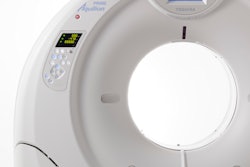In today's high-stress radiology environment, efficiency is vital, and managers now appear to be turning to detailed productivity analysis to help determine the optimal structure for job plans, U.K. researchers have reported in an article published online in the Journal of Digital Imaging.
In a pilot study that analyzed radiologist workload by calculating relative value units, the authors found that consultant (senior) radiologists who worked 12 sessions -- called programmed activities -- were more efficient than those who worked 10 or 11 programmed activities, getting through a higher mean workload per session. The reasons for these efficiency gains weren't clear, however, according to Dr. Shah Khan of Royal Blackburn Hospital and senior author Dr. Will Hedges of the University of St. Andrews.
Radiology reporting gap
While the demand for imaging services in the U.K. has increased by approximately 10% per year for the last 10 years, the number of radiologists has not matched this increase and consequently, demand is outstripping reporting capacity. In this environment, it's crucial to identify the most efficient working patterns and strategies to prevent this reporting gap from widening further, Hedges told AuntMinnieEurope.com.
Assessing radiologist efficiency requires comparing the workloads of different radiologists on an equal footing. Relative value unit systems assign scores to different imaging studies based on factors such as reporting time. Although a relative value unit system hasn't yet been utilized for workload analysis in the U.K., the researchers elected to use that approach to analyze the productivity of consultants working different number programmed activities per week. The team wanted to determine if relative value units could be applied to U.K. radiologists and if these results could identify optimal working strategies, Hedges said.
A standard full-time contract for U.K. radiologists includes 10 four-hour programmed activities, consisting of 7.5 direct clinical care activities and 2.5 supporting professional activities. However, a substantial number of consultants work more than 10 sessions, according to the researchers.
Khan and Hedges gathered reporting data for 14 radiologist consultants who worked different numbers of programmed activities at a large district hospital from April 2010 to March 2011. These data were then converted into relative value unit scores using a system that was modified by the Royal College of Surgeons and Physicians in Ireland (RCSI). The RCSI approach incorporates a range of activities such as multidisciplinary team meetings, teaching, audit, and administration into the workload analysis, and was determined to offer the best approximation of the workload of U.K. radiologists, according to the researchers (JDI, 21 September 2015).
Next, the authors calculated both crude and net workloads for each consultant by dividing their total relative value unit score by the number of programmed activities they were contracted for and how many they spent reporting.
Mean net workloads
- Consultants working 12 programmed activities (n = 8): 7,636 relative value units/programmed activities/year
- Consultants working 11 programmed activities (n = 3): 6,146.68 relative value units/programmed activities/year
- Consultants working 10 programmed activities (n = 2): 5,984 relative value units/programmed activities/year
As result, a weekly work pattern of 12 programmed activities was more efficient -- getting through a higher workload per session -- than consultants working 10 or 11 programmed activities. The difference between 12 and 11 programmed activities was statistically significant (p < 0.05). Surprisingly, consultants who worked 11 programmed activities were no more productive per session (on a statistically significant basis) than their colleagues who had 10 programmed activities per week.
"The causes for these findings are not clear," Hedges said.
While there were considerable variation in case mixes among the different groups of radiologists, none of these differences were statistically significant.
Relative value unit systems work
The study showed that relative value unit systems are useful for comparing the workloads of radiologists with different job plans and case mixes, Hedges said. He noted, however, that while relative value units can be applied to radiologists in the U.K. and used to identify efficient practices, existing relative value unit systems do not accurately reflect the modern U.K. radiology environment.
"A U.K.-specific relative value unit system would be more accurate," he said.
Depending on what practices were found to be the most efficient, hospitals could use this type of analysis in a number of ways, Hedges said. For example, they could use the results to determine how many programmed activities to include in job plans and whether to use a "duty radiologist" system, etc.
"Workload benchmarks could be developed to protect consultants from over-work and provide evidence to justify hiring more radiologists," he pointed out."On a larger scale, it could help identify whether departments would benefit from networking with other U.K. hospitals to share expertise or cover on-call duties."
In the next phase of their research, the group plans to utilize relative value units to assess productivity and cost-effectiveness in comparing reporting radiographers with consultant radiologists, Hedges said.
"Skills-mix is becoming more commonly utilized and deserves to be fully evaluated," he concluded.


















